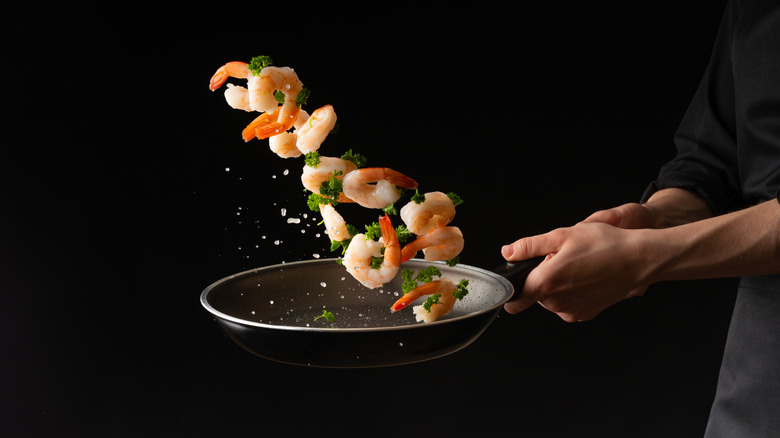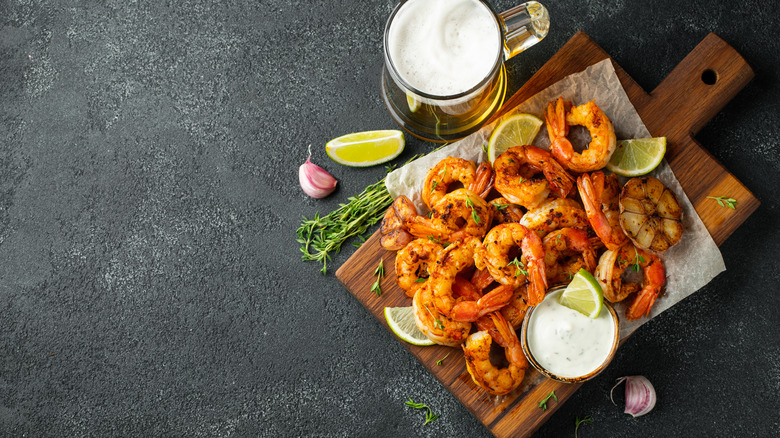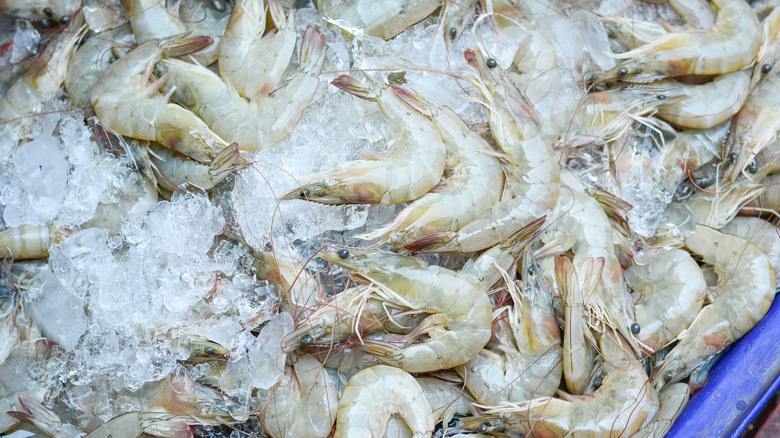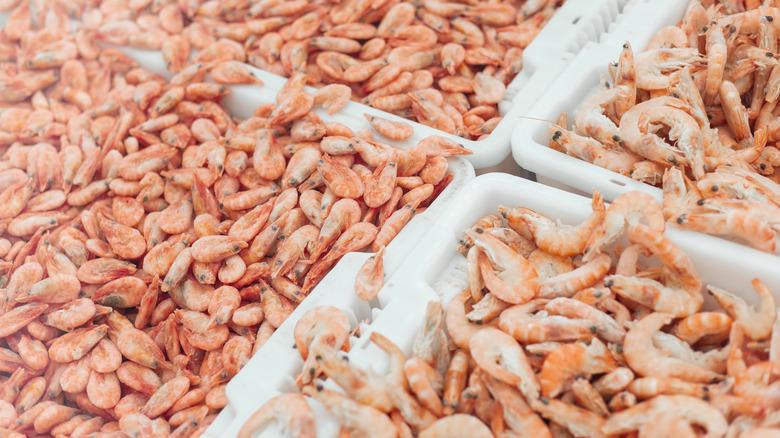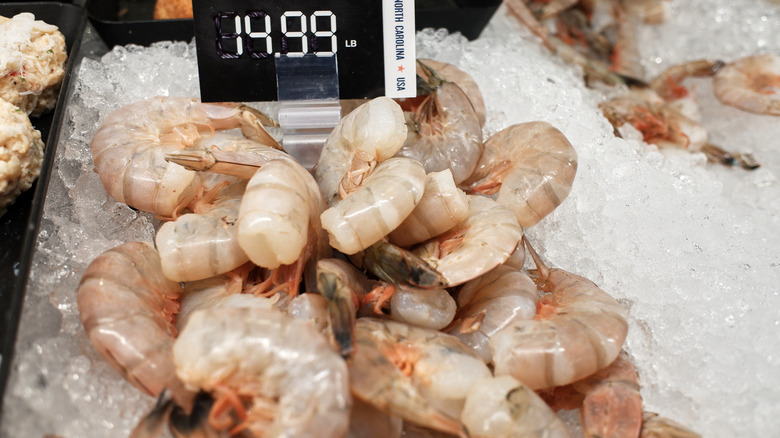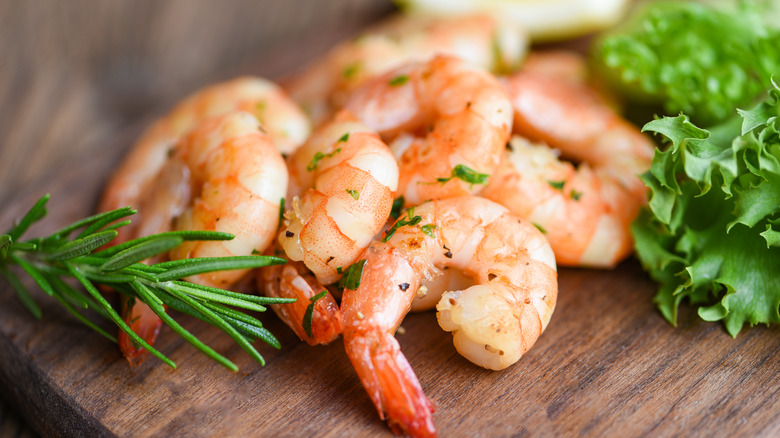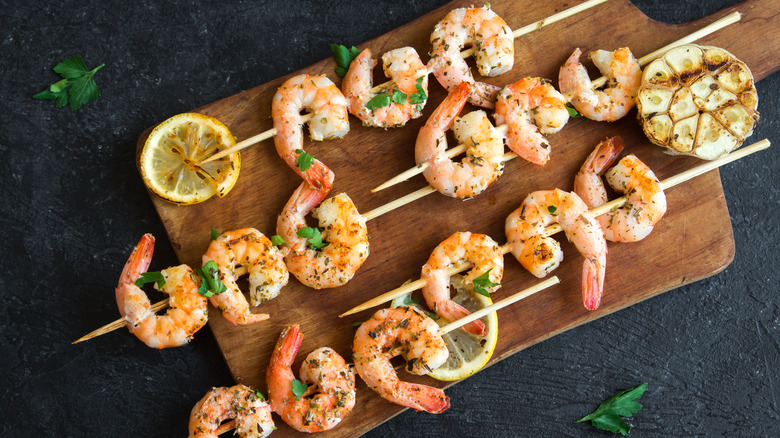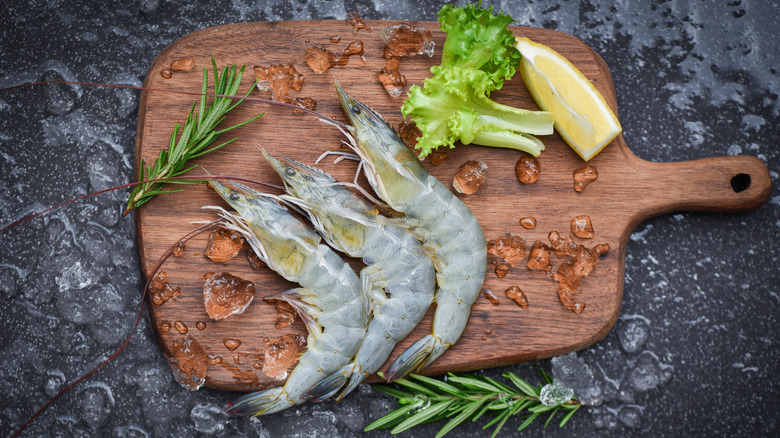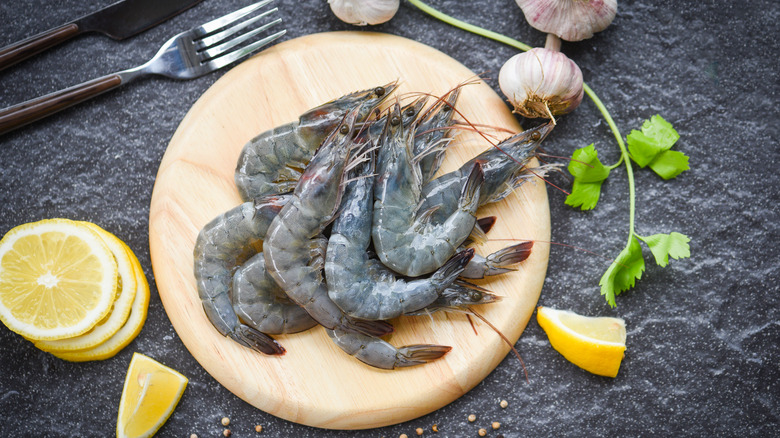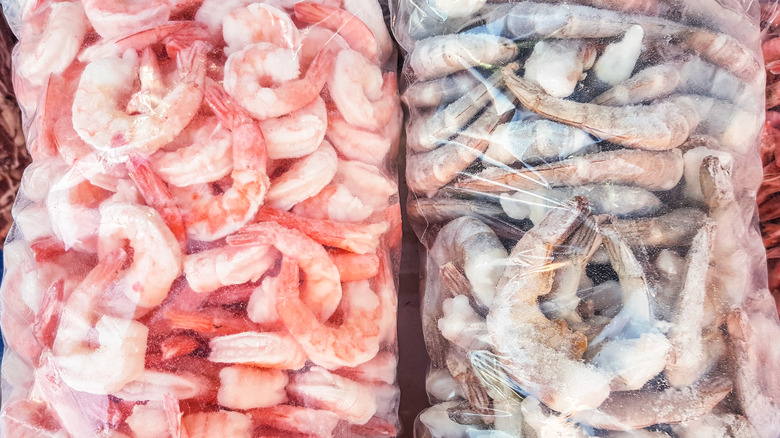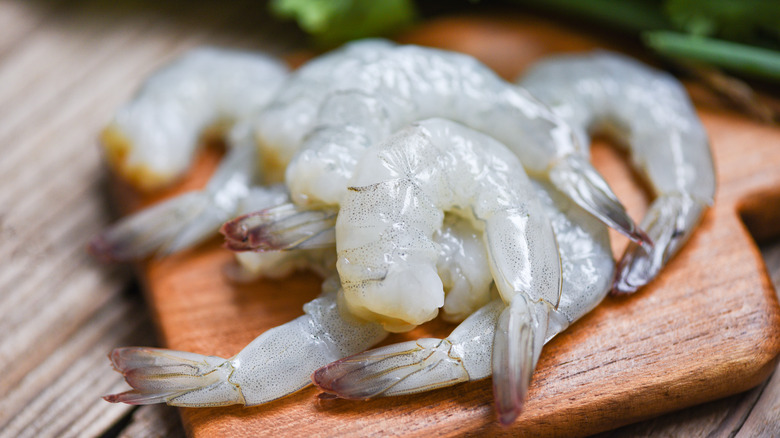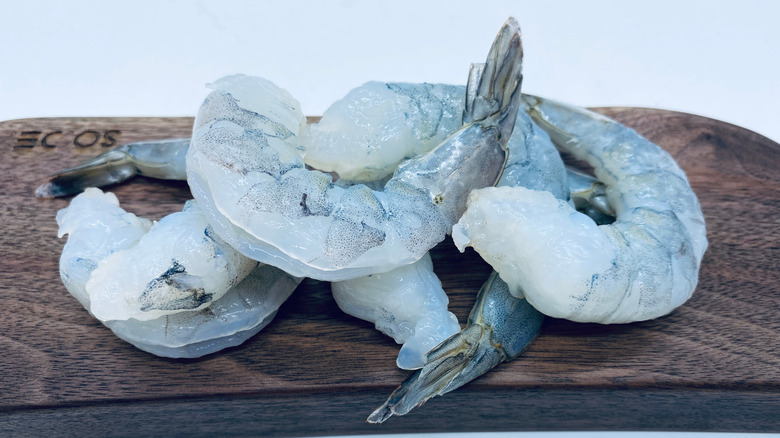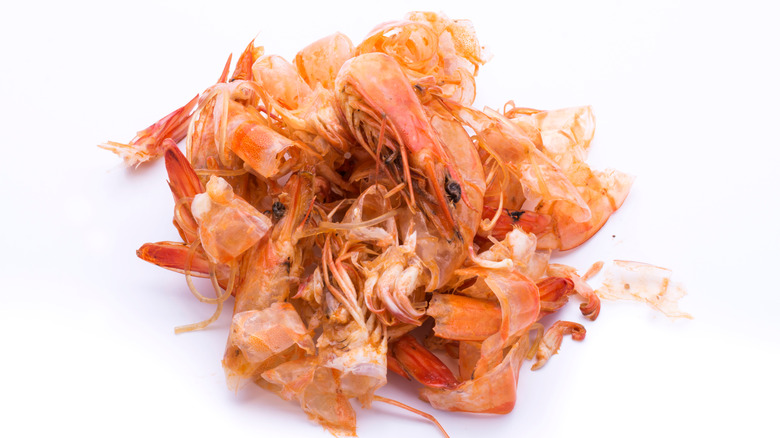Mistakes You're Making When Cooking Shrimp
Not everyone likes seafood, but if there's one type that's appealing to a wide range of people, it's shrimp. It appears on the menus of everything from the most average, everyday restaurants to the sophisticated tastemakers where you have to reserve a table six months in advance. We love shrimp, but when it comes to cooking it in your own home, there are quite a few mistakes you can make during the preparation process. Because it's such a delicate protein, you really want to take extra care when you're cooking your shrimp to ensure it tastes as tender and juicy as it should.
If you're not well-versed in cooking shrimp at home, though, that can seem like a tricky task. Luckily for you, we've compiled some of the most common mistakes people make when they're cooking shrimp. That way, you can avoid them — and hopefully make your shrimp taste better than ever before. Whether you're serving seafood to family, friends, or just yourself, everyone is sure to be pleased with the results. Don't be afraid to experiment during the cooking process. That's where you learn the best cooking lessons!
Now, let's take a look at common mistakes everyone makes when cooking shrimp.
Overcooking your shrimp
Perhaps the most common mistake of them all when it comes to cooking shrimp is overcooking. It's really easy to do, especially if you're used to cooking meat, which generally takes a lot longer to cook through. In most cases, shrimp actually cooks very quickly, so leaving it on the heat just a bit too long can result in an overcooked mess. And if you've ever had overcooked shrimp before, then you know it's tough, rubbery, and just generally unpleasant.
MyRecipes provides some tips on how you can determine whether your shrimp is cooked through or not. First of all, you're going to want to look at the color. When shrimp is cooked through, it becomes opaque, losing that transparent appearance it has when you buy it raw. Look for a pink-orange opaque color, and that's a good indicator that your shrimp is done. It can also help to feel the shrimp with your fingers. If it's too squishy, it may need to be cooked for longer. If it has no give, you've probably overcooked it. You're looking for something right in the middle.
Of course, you can always use a meat thermometer for your shrimp. This works particularly well for larger varieties. When the internal temperature reaches 165 Fahrenheit, your shrimp is done.
Purchasing the wrong kind of shrimp
The next mistake is also a common one, and it begins long before you even turn your heating element on. Rather, it comes at the time of procurement. It's easy to purchase the wrong kind of shrimp if you don't know exactly what you're looking for. It all comes down to what you plan on cooking. For example, if you're making a shrimp salad and just want little bites of shrimp mixed in with the veggies, you can opt for a smaller variety. On the other hand, if you're grilling your shrimp or plan on eating them whole, you may want to look for some that are a bit larger. However, larger shrimp generally cost more, so if you're going to be chopping them up, it's usually not worth the inflated price, according to AllRecipes.
Trying not to blow your whole grocery budget on shrimp just for one meal? We don't blame you. Those who are looking for more budget-friendly varieties might want to opt for small, pre-cooked frozen shrimp. You may even be able to find canned shrimp in some cases. It's not our favorite, but it can work as a flavorful addition to a dish. Just make sure you pick out the best shrimp for you and your budget.
Waiting too long after buying to cook your shrimp
This is one mistake you're really going to want to make sure you avoid. Of course, if you decide to buy your shrimp frozen, you're in the clear here — just put it in the freezer and get to it when you're ready. However, if you've purchased fresh or thawed shrimp, you're going to want to cook it right away. Like, within 24 hours, according to HuffPost. That's because fresh shrimp can go bad very quickly. This will leave you with a mushy, unappetizing product that could even make you sick. Therefore, it's best not to take your chances. If your shrimp looks old, has a slimy or mushy texture, or smells like ammonia, it's time to trash it.
If you know you want to cook a dish with fresh shrimp in it, make sure you go to the fish market (or wherever you're buying your shrimp) the day you're making the dish. If that's not possible, try to go the day before. Leave your shrimp in the fridge for much longer, and there's a good chance you're not going to get the fresh seafood you've been expecting.
Cooking 'fresh' shrimp from the grocery store
If your grocery store sells seafood, there's a good chance that it has a seafood counter. When you look into the seafood counter, you may think that everything looks nice and fresh, like it came straight from the ocean. You may be disappointed to realize, though, that's not always the case. According to The Spruce Eats, most of the shrimp you'll find in seafood cases at the grocery store are previously frozen, which is probably not what you think you're getting. Oftentimes, you'll pay more for these thawed shrimp than you will for the ones that are still frozen, and they'll actually be less fresh. Therefore, if you're buying from a grocery store, you will want to look for IQF (individually quick-frozen) shrimp instead.
However, if you happen to live in an area close to the coast where you have access to fresh seafood markets, you're in luck. If that's where you're sourcing your shrimp from, then you'll definitely want to buy fresh. Just make sure to cook them in time.
Forgetting to season your shrimp
Shrimp is one of those ingredients that just feels special. It's probably not something you eat every day, so it's like a little celebration when you do. Just because you're eating a highly prized protein doesn't mean you can skimp on the seasonings. Even though shrimp comes from the ocean, it can still take a lot of salt, especially since the flesh of shrimp has such a light, mild flavor. Butter or other fats can also be a great addition since shrimp isn't too fatty itself. Cooking shrimp without adding these important elements will likely result in a boring, bland meal that you won't remember tomorrow.
Actually, shrimp can handle a lot more than just salt and fat. HuffPost says that you should think of dishes like Old Bay shrimp boils and shrimp etouffee — they require a ton of seasonings, and the end results are out of this world. Therefore, you shouldn't be afraid to add whatever seasonings sound good to you. We love spicy shrimp, so adding chili powder, crushed red pepper flakes, or even gochujang could result in a tasty dish. And of course, garlic tastes good on everything, as does vinegar and lemon. Don't be afraid to add whatever sounds best to you.
Not using skewers while grilling
There are countless different ways to cook shrimp. We love shrimp in a stir-fry, but they can also be boiled, steamed, baked, air-fried — think of any cooking method, and you can probably apply it to shrimp. However, one of our very favorite ways to cook it is on the grill. Grilling shrimp lends it a rich, smoky flavor that you can't get any other way. However, putting shrimp on the grill can be a real hassle, especially if they're on the smaller side. You don't want to have to flip each one individually while you're cooking them, especially since they tend to cook so quickly. So what are you supposed to do to avoid this common mistake?
According to The Spruce Eats, you should use a skewer while you're grilling your shrimp. The skewer serves two purposes. Most importantly, it makes it easier to flip your shrimp while they're cooking. Instead of having to fiddle with tongs in an attempt to flip smaller shrimp, you can just turn over the skewer all at once. The skewer makes for a lovely way to serve the shrimp too. Who doesn't want to get a whole skewer that they can eat straight from the stick or place onto their plate? Using this simple tool can take your grilled shrimp to the next level.
Not defrosting your shrimp
If you have a convenient bag of shrimp in the freezer, you may think that it's as easy as taking them out and throwing them into a pan or into boiling water. Just one step and you're cooking, right? But we're here to tell you that not defrosting your shrimp is definitely a big mistake if you actually want it to taste good. The reasoning here is simple: According to HuffPost, if you decide not to defrost your shrimp, the shrimp is going to cook unevenly.
Think about it: The outside of the shrimp is going to cook right away because it's coming into direct contact with the heat. At the same time, the inside of the shrimp is still completely frozen. By the time the inside is cooked through, the outside is going to be way too overcooked to properly enjoy — and that's the last thing you want after you've just spent a fortune on shrimp.
Putting frozen shrimp in a pan with other ingredients can also lower the temperature of the pan, making all of your other food cook unevenly too. Simple solution? Just make sure you defrost your shrimp before you begin cooking. Luckily, it usually doesn't take too long.
Deciding not to brine
There are some types of meat that you would never dream of cooking without brining first. For example, chicken and turkey are regularly brined because it brings out a ton of flavor and tenderness in the bird. When it comes to seafood, on the other hand, a brine may not seem completely necessary. After all, wasn't this stuff just in saltwater? However, you may be interested to learn that brining your shrimp is an excellent idea, and failing to do so can result in a less appetizing meal than you could have if you were to just take this extra step.
Wondering how to do it? Luckily, it's both inexpensive and simple. All you have to do is place your shrimp in a bag or bowl and add some salt — make sure you add quite a bit. According to Julington Creek Fish Camp, you'll want to brine unpeeled shrimp for about 40 to 60 minutes, while peeled shrimp will only require about 20 to 30 minutes of brining time.
It does require a bit of prep before you start cooking, but you may just be surprised at how much more flavorful your shrimp is if you decide to take this step before you cook.
Improperly defrosting your shrimp
You already know that you have to defrost your shrimp ... but how can you make sure that you're actually thawing it the right way? While it may be easy to set other types of meat out on the counter for a few hours before you start cooking, that's not the ideal way to defrost shrimp — they spoil too quickly for this method, and they could become a food safety concern. Additionally, per AllRecipes, thawing in the microwave is out of the question too, and even putting your shrimp in warm water isn't ideal. Since shrimp cook so quickly, this could lead to an overcooked meal, and that's the last thing you want.
The best way to defrost? Simply put your shrimp into a colander over a bowl in the refrigerator and let them thaw overnight. This method does take some forethought, but it's super simple. If you can't wait that long, throw the shrimp in a bag and place the bag in lukewarm water. Avoid putting the shrimp directly into the water, as they can get waterlogged.
Taking the shells off before cooking
If you're used to eating shrimp without the shells on and you happen to buy some that still have their shells, you may think that you need to get rid of them as soon as possible. After all, you may not want to have to peel the shrimp on your plate. However, we're here to tell you that in many cases, removing the shell before you start cooking is a bad idea. This is especially true when you decide to grill your shrimp, according to The Spruce Eats.
Why? Because when you grill, you're exposing the shrimp to high, intense heat, which can quickly dry out their delicate flesh. The shells act as a protective barrier, keeping the meat away from the hottest parts of the flame and trapping in moisture so you aren't left with a tough, dried-out crustacean to gnaw on. When you're ready to eat, just pull the shells off — you should be able to remove them easily after cooking. You'll be amazed at what a difference leaving the shells on makes.
Not deveining gently enough
Deveining a shrimp doesn't actually have to do with a vein at all. Instead, you're taking out a part of the animal's digestive tract. While you don't technically have to devein your shrimp if you don't want to, many people think it tastes better when they do. However, if you're still new to the deveining process, it can be a little tricky, so you'll want to make sure you take your time so as not to mangle the shrimp.
HuffPost points out that since shrimp are delicate, it's easy to mishandle them. Before you devein your shrimp, you'll want to know exactly what you're doing. If you don't, head to YouTube to check out a tutorial. Then, grab a sharp knife or a pair of kitchen shears. You're going to end up with a huge mess if you use a blade that's too dull. Once you've deveined your shrimp, they should be ready to add to just about any dish you want.
Trashing the shells
Here at Mashed, we're all about reducing food waste, but sometimes, it involves more creative thinking than just remembering to use up the zucchini you have in the fridge. After you're done cooking and shelling your shrimp, you might just head to the trash can to throw your shrimp shells away. Not so fast! Throwing those shells away means throwing away a ton of flavor, and that's the last thing you want to do.
Instead, AllRecipes recommends keeping those shells (and the heads!) for future use. Putting the shells into a big pot of boiling water along with the spices of your choice can make an incredibly flavorful seafood broth that you can use for just about anything, from soups to pasta to risottos. If you don't want to cook the stock right away, you can freeze the shells and do it whenever you have the time.
Haven't tried seafood stock before? Trust us, it's delicious, and it'll make an excellent addition to your meal prep repertoire. And since this is a great way to use up what you already have, you can feel good about the fact that you're not wasting food or money.
